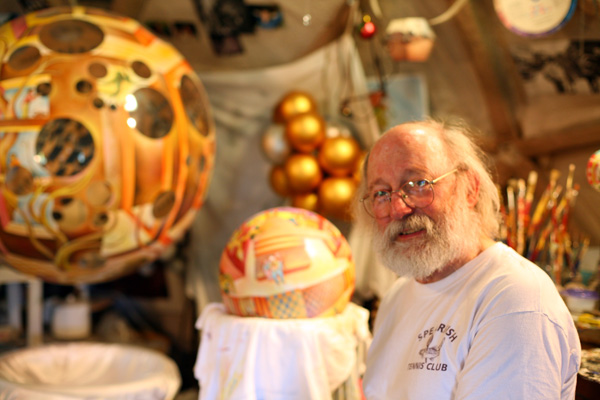
We visited my friend Dick Termes in Spearfish, South Dakota. He’s an amazing artist, he paints on spheres instead of on flat canvases. He calls his works Termespheres.
His www.termespheres.com website has some great explanations of how does his work.
In this shot of him in his studio, you can see his “easel” which is a cloth-draped ring resting on an armature that rises up and down and rotates. It holds the sphere in progress.
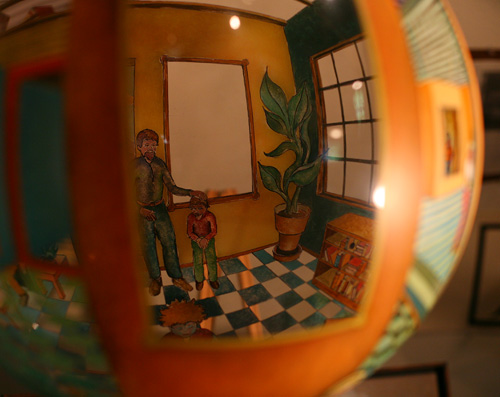
In the background is a new kind of sphere he’s working on, one in which there are transparent windows through which you can see into the interior. He paints a (slightly) different inward-pointing image beneath the outward pointing image.
The best way to understand these works is to look at a video of some rotating Termespheres:
It’s really remarkable how the perspective seems to go into the spheres. You may also notice sometimes that your mind “reverses” the perspective, so that the sphere looks concave rather than convex. Note that when this happens, the sphere seems to rotate the other way. How does he create these works?
As I explained in a 2004 post about him:
Termes’s painting method consists of getting a spherical canvas, standing in front of it, and painting onto the canvas what you see on the other side of the sphere, in front of you. Termes does not work by painting what is behind him onto the sphere, all the while looking over his shoulder. He paints what is in front of him. Once he has finished a patch corresponding to what is in front of him, how does he add what is, say, to the left of the patch in front of him? He moves around the sphere to the right a little so that he is now looking directly at the area that was formerly to the left. And he rotates the sphere to the right so as to expose the blank part of the sphere canvas to the left of what he already painted.
Mathematically, this is equivalent to central projection of the world onto the inner surface of the sphere, followed by eversion. By eversion I mean this: turn the sphere inside out. This way the correctly projected image which was visible from the inside is now visible from the outside.
If you were to try and do this yourself, you’d probably end up with a mess. Termes’s other innovation is that he has developed a “six-point” form of perspective that allows him to organize what he paints on the sphere.
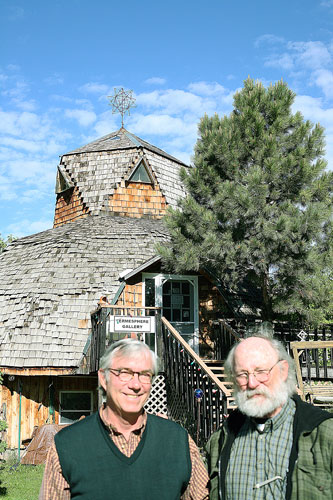
In 1997, I spent three or four days visiting Termes, sleeping in this polyhedral dome on top of his gallery, doing research for my novel Saucer Wisdom, which has it’s final scenes in Spearfish and at the nearby Devil’s Tower, Wyoming. I have a journal entry about this trip in my Saucer Wisdom Notes PDF online.

When I returned last week, an amazingly violent thunderstorm came through during the night. Dick said the Black Hills of SD are known for their thunderstorms and that, although the Native Americans would hunt there, they preferred to sleep away from the hills in the grasslands.

He assures me that the stellated icosahedron on the dome above his gallery is grounded.
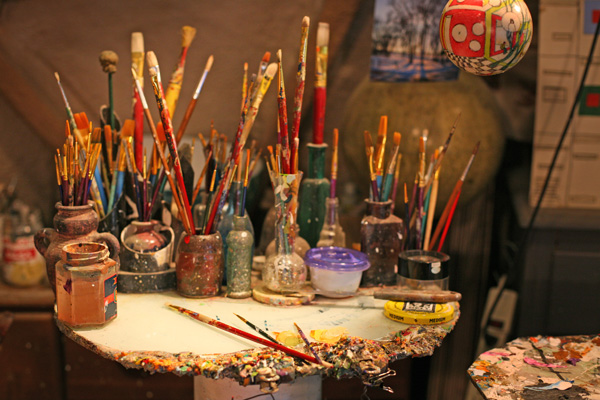
Termes is a real old-master kind of artist, it was great just to look at his brushes. Seeing him again gave me some ideas about how to round out my Bosch character in Hylozoic. Termes is very excited and enthused about his work, and I can imagine that Bosch was too.

While we were in Sioux City, SD, we visited a four-foot diameter Termesphere on display in the Sioux City convention center. Termes has gotten a number of public art commissions over the years.
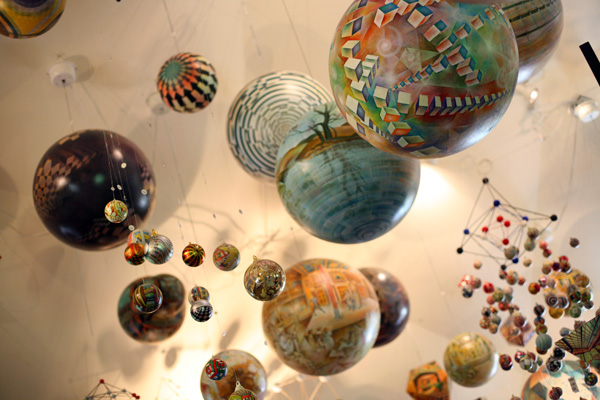
He has a gallery built on to his house, with a zillion decorated spheres dangling from the ceiling. You can go online to see what’s for sale .
Prices range from about $5000 to $20000 in the gallery but there are also some silk screened spheres for $200. If people want the actual price for a specific piece Dick will email that to them or talk to them on the phone. About half of his pieces are done on commission, and on these, the prices vary according to what the patron wants.
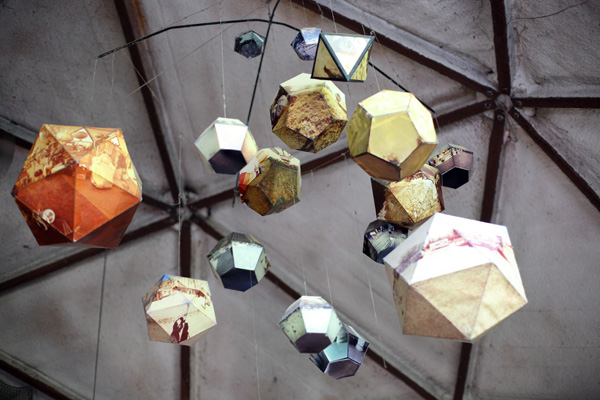
He’s into polyhedra too, and at one time was working with a system he calls “Total Photography” for mapping sets of photos onto polyhedra. His online store sells a variety of low-cost reproductions, such as paintings on polyhedra.
Naturally his house is all made of domes, that’s the living room ceiling in the picture of the polyhedron mobile. It’s very cozy in there. The spherical ceiling has this odd property of focusing sounds, so that if you sit at the right distance from Termes, it’s like he’s talking into your ear.
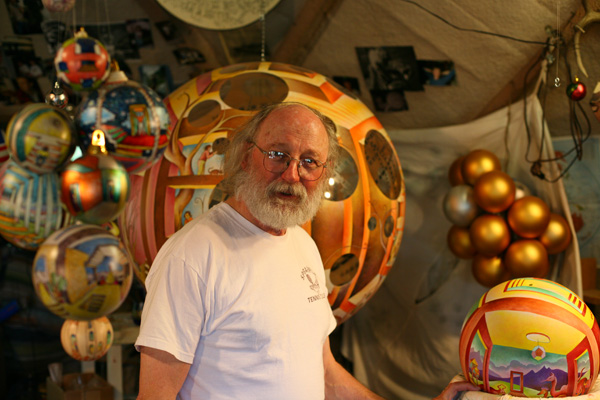
Those gold decoration-type balls in the studio picture above are waiting to be coated with gesso and used as “sketch paper”! Whenever Dick runs across mass-produced spheres at a good price he gets a bunch of them; he says the big Xmas balls at K-Mart make good “canvases.”
Thinking about the amazing achievements of Dick Termes — as compared to the relative obscurity in which he works — I recall a remark that Jorge Luis Borges made in an essay about the writer Herman Melville.
Vast populations, towering cities, erroneous and clamourous publicity have conspired to make unkown great men one of America’s traditions.
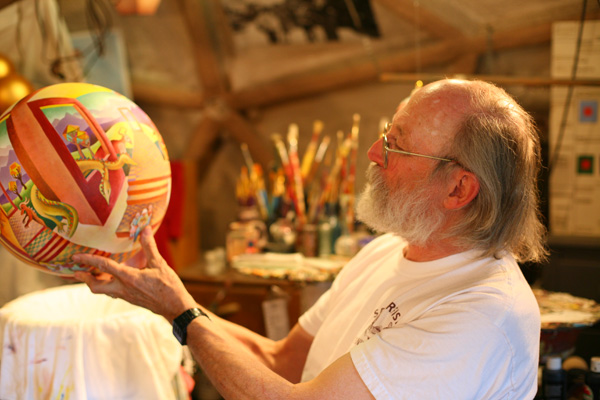









June 26th, 2008 at 5:11 pm
Painting a sphere I can grok, but how does he SILKSCREEN a sphere?
June 26th, 2008 at 6:59 pm
To silkscreen a sphere, I think Dick does a spherical painting, photographs it from above and below, prints those (bunched up at the edge) images onto plastic disks, heats the disks and stretches them into hemispherical shapes, and joins the hemispheres together. They look pretty good.
June 27th, 2008 at 6:19 am
Drat, you’ve ruined his obscurity. Now he’ll get multi-million-dollar commissions by the dozens and everyone will know his name. By xmas he’ll be partying with Paris Hilton and painting portraits of Kanye West on empty Cristal bottles. Driving an icosahedron-shaped car. Slapping airport security guards.
Seriously, wow! Laboring in obscurity is the key phrase – he’s invented a whole art form here, tools and esthetics included. He’s due some recognition.
June 27th, 2008 at 10:14 pm
Wow those are amazing. The video is great to demonstrate the perspective. Just tell me how many digits they cost. I really want one (or more) of those, but I’m guessing they are pretty solidly not affordable by me.
June 28th, 2008 at 12:02 pm
Hi,
Thanks for this wonderful story of Dick. He was my professor the summer of 1970. I was just as impressed with him then as I am now. I am a sociology professor and still love his work. Plus, he is an amazing human being in all his genius ways. Ammertte “Amy” Deibert
June 28th, 2008 at 3:08 pm
Fantastic and wonderful artwork. It’s people like Dick Termes who make America
the great country it is.
However I would put you at the head of the list of America’s “unkown great men”!
Also the list would be George Herriman and Windsor McKay.
June 29th, 2008 at 2:36 pm
this one rudy somehow coagulates meinterbrain-ocity – this is mere ufophonic interfence ofthe bob pipe aroundthe veldt of O’ryno bobalon – ww soon be X-day again
July 1st, 2008 at 11:16 am
For those of us who can’t spare the few grand for the very cool spheres, he has some (much) smaller pieces that he’ll part with for under $100. I’d also highly recommend the Einstein spherical mirror.
Scott
July 1st, 2008 at 12:02 pm
I first learned of Dick Termes’ amazing spheres in 2007 from the book “Masters of Deception”. I struck up an email correspondence with him and my family and I planned a vacation to the Black Hills of South Dakota over Memorial Day Weekend to purchase a sphere (The Spirit of Gothic Hall). What a kind and gracious host! We spent 2 wonderful hours learning about all facets of his work (e.g., the “Total View” camera, a tour of his studio (of which Rudy has some great shots above, etc)). A wonderful experience and meeting that exceed all my expectations…. I hope to get back to Spearfish, SD for another (and longer visit) someday.
I’m certainly trying to spread the word out here in Southern California; I’ve emailed several museums to see if they’d like to exhibit the Termesphere but most say they can’t insure it or guarantee it’s safety. I still have (surprisingly) one interested correspondence from the Getty; though they rarely display anything so recent, I’m hoping the subject matter (a 14th century European interior) and uniqueness of the the art gets them to bite.
July 3rd, 2008 at 11:41 pm
this is very wonderful arts. i am glad to know such things.
August 30th, 2008 at 1:28 pm
hey this one caught me – this guy is great – where can i get it ?